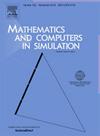An agile modeling framework for population dynamics
IF 4.4
2区 数学
Q1 COMPUTER SCIENCE, INTERDISCIPLINARY APPLICATIONS
引用次数: 0
Abstract
In this work, we present an agile modeling framework for structured population dynamics, leading to automated generation of population models’ equations. The structure of a population, i.e. its separation in strata, according to one or many criteria (such as sex, income, health, geographic area or species if dealing with animal populations), represents a major issue for the precision and richness of population dynamics simulations. The intensity of some phenomena and mechanisms is highly dependent on the involved subpopulation characteristics. This modeling framework can be seen as an extension of the classic McKendrick–von Foerster equation, which embeds the population structure. It allows showing, under appropriate hypothesis, an existence and local uniqueness result for the solution of a transport equation. A modeler has been implemented, to generate models that respect the desired structure hypotheses. We illustrate its abilities on an age-structured predator–prey model, subject to migratory dynamics and to an epidemic, based on a SIRD model.
种群动态的敏捷建模框架
在这项工作中,我们提出了一个结构化种群动力学的敏捷建模框架,导致种群模型方程的自动生成。一个种群的结构,即根据一个或多个标准(如性别、收入、健康、地理区域或物种,如果涉及动物种群)将其分层,是种群动态模拟精度和丰富性的一个主要问题。某些现象和机制的强度高度依赖于所涉及的亚种群特征。这个建模框架可以看作是经典的McKendrick-von Foerster方程的扩展,该方程嵌入了人口结构。它允许在适当的假设下,给出输运方程解的存在性和局部唯一性结果。已经实现了一个建模器,以生成尊重所需结构假设的模型。我们在基于SIRD模型的年龄结构捕食者-猎物模型上说明了它的能力,该模型受迁徙动力学和流行病的影响。
本文章由计算机程序翻译,如有差异,请以英文原文为准。
求助全文
约1分钟内获得全文
求助全文
来源期刊

Mathematics and Computers in Simulation
数学-计算机:跨学科应用
CiteScore
8.90
自引率
4.30%
发文量
335
审稿时长
54 days
期刊介绍:
The aim of the journal is to provide an international forum for the dissemination of up-to-date information in the fields of the mathematics and computers, in particular (but not exclusively) as they apply to the dynamics of systems, their simulation and scientific computation in general. Published material ranges from short, concise research papers to more general tutorial articles.
Mathematics and Computers in Simulation, published monthly, is the official organ of IMACS, the International Association for Mathematics and Computers in Simulation (Formerly AICA). This Association, founded in 1955 and legally incorporated in 1956 is a member of FIACC (the Five International Associations Coordinating Committee), together with IFIP, IFAV, IFORS and IMEKO.
Topics covered by the journal include mathematical tools in:
•The foundations of systems modelling
•Numerical analysis and the development of algorithms for simulation
They also include considerations about computer hardware for simulation and about special software and compilers.
The journal also publishes articles concerned with specific applications of modelling and simulation in science and engineering, with relevant applied mathematics, the general philosophy of systems simulation, and their impact on disciplinary and interdisciplinary research.
The journal includes a Book Review section -- and a "News on IMACS" section that contains a Calendar of future Conferences/Events and other information about the Association.
 求助内容:
求助内容: 应助结果提醒方式:
应助结果提醒方式:


